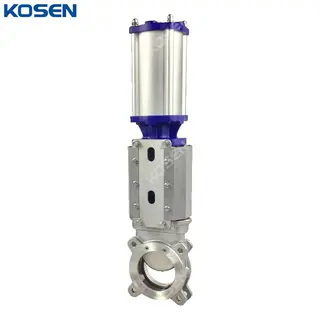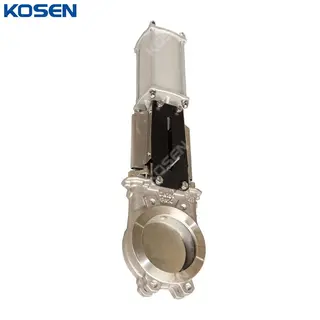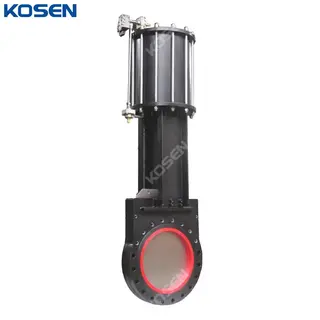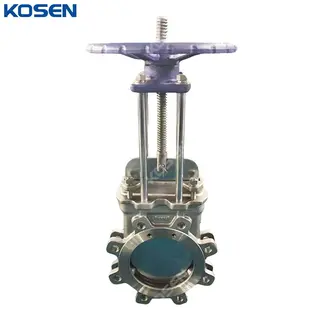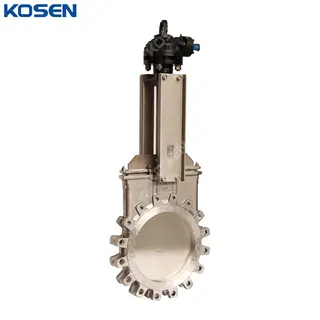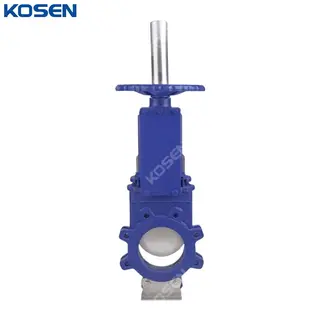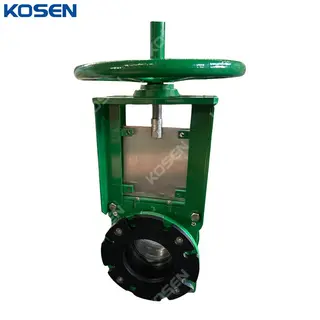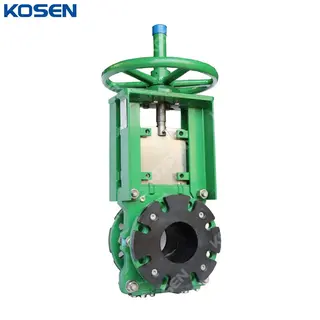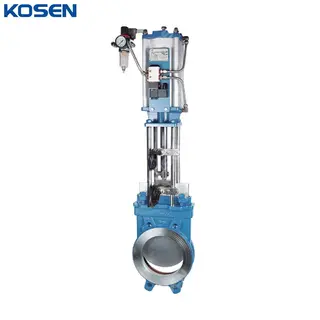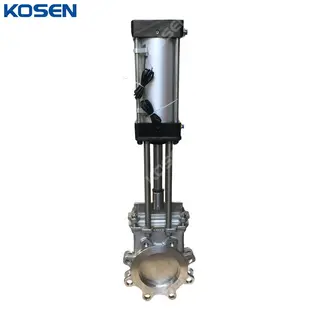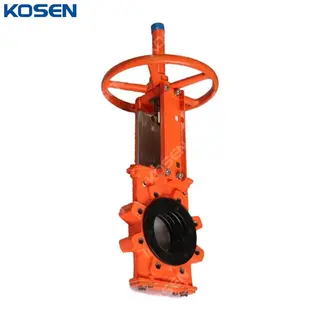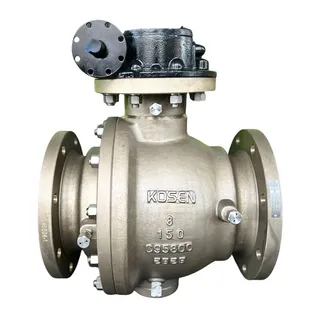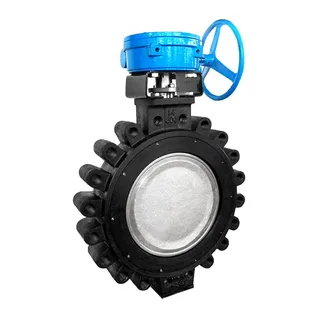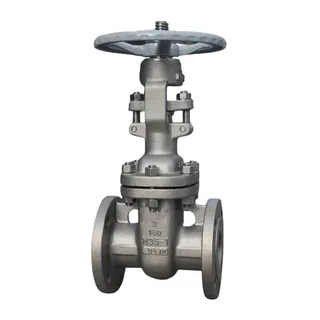Knife gate valves function through the vertical movement of the gate to open and close the valve, making them widely used in applications requiring either full open or full close positions. The following are the key points of their working principle.
Opening and Closing Process: When the gate descends, it tightly fits the valve seat, preventing fluid from passing and completing the closing process. When the gate rises, the medium flows smoothly, thus achieving the open position.
Structural Features: The valve body has an angled cut at the bottom resembling a blade, which enables the valve to cut through the medium in the pipeline, preventing blockage from affecting operation. This feature makes knife gate valves suitable for pipelines carrying media such as pulp, furnace slag, coal ash, and wastewater.
Operation Method: Manual knife gate valves are operated by rotating the handwheel, which drives the valve stem to move up and down, thus opening and closing the gate. When the handwheel is rotated clockwise, the valve closes; when rotated counterclockwise, the valve opens.
Internal Linkage Mechanism: The internal components of the knife gate valve are linked via a lever and gear mechanism, which drives the gate to move rapidly for opening and closing. When in the open position, the gate is fully raised and flush with the top of the valve body, allowing the medium to flow unobstructed. In the closed position, the gate lowers and presses tightly against the valve seat to ensure a leak-proof seal.
The core structure of a knife gate valve consists of the valve body, gate, valve stem, and drive mechanism. Each component works in coordination to effectively control the flow of fluids. Below is a description of the main components and their functions.
Valve Body: The valve body is the main part of the knife gate valve, typically made from cast iron, carbon steel, or stainless steel, ensuring strength and durability. The internal design of the valve body features a smooth, unobstructed passage, facilitating the flow of solid particles or viscous media. Fluid enters through one side of the valve body and exits through the other side after passing through the passage.
Gate: The gate is a critical part of the knife gate valve, usually made from metal materials such as cast iron, carbon steel, or stainless steel. The gate is typically a flat or slightly wedge-shaped piece with a blade-like structure at the bottom for cutting through the medium. When the valve is open, the gate rises and aligns with the passage, allowing fluid to flow freely. When the valve is closed, the gate lowers, completely blocking the flow.
Valve Stem: The valve stem connects the gate to the drive mechanism and is responsible for driving the vertical movement of the gate. The stem is usually made from carbon steel or stainless steel, providing high strength and corrosion resistance. The top of the stem is equipped with a handle or gear, allowing the user to rotate the handle or gear to control the gate's position.
Drive Mechanism: Depending on the application, knife gate valves can be equipped with various drive mechanisms, including manual, electric, pneumatic, or hydraulic drives, to meet different operational requirements. Manual mechanisms are typically used for smaller valves, while electric or pneumatic drives are used for larger valves or those requiring frequent operation.
Sealing Mechanism: The sealing mechanism is an essential part of the knife gate valve, typically consisting of soft seals or packing, installed between the valve body and the valve stem to prevent fluid leakage. Its purpose is to ensure a tight seal, enhancing the safety and reliability of the system.
Knife gate valves are categorized based on their structural form and sealing method. Each type has different characteristics and is suited for specific applications, meeting the flow control needs of various conditions. Below are the common types of knife gate valves.
Rising Stem Knife Gate Valve: This valve has a simple structure, consisting of a valve body, gate, valve stem, and sealing components. It is cost-effective and easy to install, making it suitable for general medium control applications. It is commonly found in industrial pipeline systems where basic flow control is required.
Through Conduit Knife Gate Valve: This design allows the gate to penetrate the valve body, ensuring complete shutoff of the medium when the valve is closed. It offers better sealing performance and lower flow resistance, making it ideal for applications requiring strict sealing and low flow resistance, such as high-precision fluid control.
Non-Rising Stem Knife Gate Valve: In this design, the valve stem is hidden inside the valve body, resulting in a more aesthetically pleasing appearance and a smaller footprint. It is suitable for installation in confined spaces, such as indoor pipeline systems, where saving space and enhancing overall aesthetics are important.
Unidirectional Sealing Knife Gate Valve: The gate's front side must face the direction of the medium flow, with the medium flowing only in one direction. Installation requires the flow direction to align with the arrow on the valve body. This type of valve is suitable for unidirectional flow systems.
Bidirectional Sealing Knife Gate Valve: This design allows the gate to face either direction of medium flow, with no flow direction indicated on the valve body. Because of the greater force on the valve stem, the stem diameter is typically larger than that of unidirectional sealing valves. This type is suitable for bidirectional flow systems.
Choosing the correct knife gate valve is a key step to ensure its efficient operation in a pipeline system. Factors such as size, material, operating environment, and method of operation should be considered.
Size Selection: The size of the knife gate valve is closely related to the pipe diameter. Ensure that the valve size matches the pipe to maintain flow efficiency and sealing integrity. A valve that is too large or too small can increase flow resistance, cause leakage, or make operation difficult. Therefore, accurately measuring the pipe's internal diameter and referring to industry standards or the manufacturer's recommendations is essential.
Material Selection: The material should be chosen based on the characteristics of the fluid (e.g., acidity, corrosiveness, temperature). Common materials include cast iron, stainless steel, and alloy steels. For corrosive fluids, corrosion-resistant materials like 316L stainless steel or high-alloy materials are recommended. For high-temperature environments, materials like chromium-molybdenum steel should be selected. Proper material choice extends the valve's lifespan and reduces maintenance costs.
Application Environment: Knife gate valves are widely used in various industries, including water treatment, mining, chemicals, and food processing. Each environment has its specific requirements. For example, food-grade applications require valves that meet hygiene standards and are easy to clean, while applications handling slurry or solid particles require valves that are wear-resistant and capable of handling solids. Understanding the specific working conditions, such as the presence of abrasives, frequency of opening and closing, and particle content, is essential for selecting the right valve.
Operation Method: Choose the appropriate operation method based on the application and automation needs. Common methods include manual, electric, and pneumatic operation. For applications requiring frequent remote operation, electric or pneumatic knife gate valves are more suitable, offering improved convenience and faster response times.
Knife gate valves are widely used in various industrial applications due to their simple structure, excellent sealing performance, and low flow resistance, making them ideal for fluid shutoff and control. However, they also have certain limitations. Understanding these advantages and disadvantages helps to better assess their suitability and performance in specific applications.
Simple Structure: Knife gate valves consist of a valve body, gate, and actuator, offering a straightforward design that makes installation, operation, and maintenance easier.
Fast Opening and Closing: With the gate's quick movement, knife gate valves can open and close rapidly, making them suitable for applications that require frequent flow adjustments.
Excellent Sealing Performance: Knife gate valves feature superior sealing, often using metallic or elastic sealing gaskets that prevent medium leakage and enhance system efficiency.
Durability: The sealing surfaces of the gate and base are made from hard materials that can withstand high flow rates, high viscosity, and particulate-laden media, extending the valve's service life.
Space-Saving and Efficient: Knife gate valves are compact and lightweight, making them easy to transport and install in tight spaces. Additionally, their low flow resistance reduces energy loss during fluid transmission, improving system efficiency.
Low Flow Resistance: In the fully open position, the valve's flow passage is completely straight, resulting in low flow resistance (approximately 0.08 to 0.12), which is advantageous for reducing pressure loss, especially in long-distance media transport.
Self-Sealing Capability: Knife gate valves can achieve a tighter seal under suitable operating conditions due to the medium's pressure, providing a certain degree of self-sealing that reduces leakage risks.
Low Maintenance Requirements: Thanks to their simple structure, knife gate valves require less maintenance and have fewer failure points.
Impact Noise and Vibration: Knife gate valves may produce noise and vibration during the opening and closing process, which could affect nearby equipment and pipelines.
Large Operating Force and Space Requirements: The opening and closing of knife gate valves require considerable force and space, which may pose challenges in confined or complex environments.
Limited Control Performance: Knife gate valves are primarily designed for fluid shutoff, with simple flow control and no precise adjustment capability. This can lead to medium blockage and leakage.
Not Suitable for Flow Regulation: Due to their structural characteristics, knife gate valves may cause significant pressure loss during throttling, leading to unstable flow control, making them unsuitable for flow regulation.
Limited Pressure Application: Knife gate valves are typically suited for medium- and low-pressure pipelines and may not meet the requirements in high-pressure environments, limiting their use in high-pressure pipelines.
Material Performance Limitations: In extreme temperatures (high or low), the material performance and sealing effectiveness of knife gate valves may be affected, restricting their application in such conditions.
When installing a knife gate valve, it is essential to ensure that each step follows standard requirements to ensure the valve operates correctly and lasts long. Here are key steps and considerations for installation.
Pre-Installation Inspection: Before installation, check the valve's interior and surfaces for any dirt or small particles. Cleaning the internal components ensures proper sealing and smooth valve operation.
Connection and Tightening: During installation, ensure all bolts are tightened evenly. Proper tightening ensures the valve is securely installed and maintains its sealing performance, preventing leaks or poor operation due to improper installation.
Packing Area Inspection: The packing area should be adjusted to an optimal tightness to guarantee a good seal while ensuring the valve operates smoothly. Over-tightening or under-tightening can affect valve performance, so adjust as needed based on actual conditions.
Model and Specification Confirmation: Before installation, confirm that the valve's model, specifications, and materials match the pipeline system requirements. This is crucial to ensure compatibility with the system's flow direction and prevent issues during operation.
Space for Actuator: Allow enough space for the valve's actuator during installation. The actuator wiring should follow the circuit diagram and system specifications to ensure proper operation of the valve control system.
Maintenance and Care: After installation, regularly inspect and maintain the valve to avoid impacts or pressure that could damage the sealing. Also, avoid improper storage to keep the valve in optimal working condition.
Knife gate valves, known for their corrosion resistance, wear resistance, and sealing performance, are used in a wide range of industries. Below are typical applications in various fields:
Industrial Wastewater Treatment: In industrial wastewater treatment systems, knife gate valves are used for isolating and regulating wastewater flows. Their corrosion resistance makes them suitable for handling corrosive substances in wastewater, while their wear resistance ensures stable operation even with solid particles in the medium.
Coal and Ore Transport: Knife gate valves control material flow in coal and ore transport systems. Their sturdy design and gate structure are effective at cutting through solid particles, making them ideal for high-concentration solid media handling, ensuring efficient operation in transportation systems.
Food and Pharmaceutical Industries: In the food and pharmaceutical industries, knife gate valves control fluid flow. Their excellent sealing performance and sanitary design (such as no dead spaces) make them suitable for high cleanliness standards, ensuring product quality and safety while meeting strict industry standards.
Power and Water Treatment Industries: In power and water treatment industries, knife gate valves control the flow of cooling water, circulating water, and chemicals. Their reliable sealing performance and high-temperature resistance allow them to operate stably in high-pressure, high-temperature environments, adapting to complex conditions.
Construction and Municipal Engineering: Knife gate valves are commonly used in construction and municipal engineering to control the flow of sewage and stormwater. Their simple structure, easy operation, and low maintenance requirements make them ideal for long-term use, ensuring the stability and reliability of fluid control systems.
Maintenance and Care of Knife Gate Valves
Regular maintenance and care are crucial to ensure the long-term stable operation and extended lifespan of knife gate valves. Regular checks and servicing can effectively prevent failures, ensuring high efficiency and reliability. Below are the key maintenance and care tasks.
Regular Inspections: Inspect the valve body, gate, sealing rings, and other parts for wear, cracks, or looseness. Address potential issues promptly to avoid further damage to the equipment.
Keep Clean: Ensure the valve interior remains clean to prevent impurities or dirt from entering the valve, which can disrupt normal operation or even cause jamming or damage. Regular cleaning is essential for maintaining proper valve function.
Lubrication and Anti-Corrosion: Periodically lubricate the actuator to prevent rusting and jamming. Proper lubrication ensures smooth operation and reduces wear, extending the valve's service life.
Check Bolts and Nuts: Regularly check and tighten the valve's bolts and nuts to ensure they are secure and prevent leakage or failure due to loosened connections.
Sealing Performance Testing: Periodically test the sealing performance to ensure that the valve does not leak air or liquid. If the sealing rings are damaged or performance deteriorates, replace them promptly.
Storage Environment: Store knife gate valves in a dry, ventilated area to prevent corrosion from moisture or water accumulation. When storing, plug both ends of the valve to prevent foreign matter from entering.
Maintenance of Installed Valves: For installed and operational valves, perform regular inspections, check for wear on the valve stem and nut, and ensure that the bolts on the flange and bracket are intact, with no thread damage or looseness. Replace aging or failed packing as needed.
In conclusion, knife gate valves offer a versatile and reliable solution for fluid control in a variety of industries. Their simple design, efficient sealing capabilities, and low maintenance requirements make them ideal for applications where durability and ease of use are key priorities. While they excel in certain environments, it's important to carefully consider their limitations, such as their suitability for flow regulation and the space required for operation. By understanding both their advantages and constraints, users can ensure they are applied where they provide the most benefit, maximizing performance and reliability.

